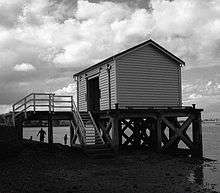Whangateau
Whangateau is a small town on the east coast of the North Island of New Zealand. It is situated in Rodney District, part of the Auckland Region, and is on a peninsula stretching out into the Hauraki Gulf, north of Auckland. Whangateau is on the northern shore of Whangateau Harbour which is fed by the Omaha River and separated from Omaha Bay by the Maungatawhiri sandspit. The settlement is in two parts of 20 to 30 houses each. The main settlement includes a large public reserve with sports fields and a campground. There is also a public hall which hosts music events and a flax weaving group. The smaller settlement is Tram Car Bay, named for two tram cars which were used as holiday homes. Whangateau is situated between the rural settlement of Matakana and the fishing village of Leigh.A tsunami siren is located in the town.[1]
History
The wider Omaha area around Whangateau Harbour was a favourite source of fish and birds for Māori tribes for centuries before the arrival of Europeans. (Omaha means 'Place of Plenty'). There were many disputes over control and the only tribe in residence at the time of the first European settlement was Ngāti Wai, whose chief Te Kiri gave the Leigh marae its name.

In 1858 the Pakiri block was purchased from Maori by the Crown and in 1892 the area around Whangateau was surveyed into 30 or 40-acre (160,000 m2) blocks for settlement by immigrants from England and Scotland. The public reserve, which is on the waterfront, was surveyed and plans for a school and hall were formulated. Smaller house sites were established close to the reserve. The school was later closed but a hall was built around 1898, and remains today as the focal point of the settlement. Until the 1980s there was a store located on the main road, which was featured in a 1985 Tip Top Trumpet television commercial starring Kiwi model Rachel Hunter.
A cemetery established on a high promontory overlooking the harbour has the remains of many early settlers and is still used for burials. A camp ground was established on the reserve and was run by the local community until 1997 when control was taken over by the Rodney District Council. Horse races used to be held on the mudflats of the harbour at low-tide. The community also developed sports fields on the reserve and it remains a popular site for various sports fostered by the Rodney Rams Sports Club. The clubhouse itself was destroyed by fire in 2014.[2] Whangateau was a centre for trade during the 1800s as there were no roads and all traffic was by sea. The recently restored Big Omaha wharf was used to berth coastal shipping taking apples and kauri gum (resin) to the Auckland markets. It was adjacent to two important ship building facilities owned by the Darrochs and Meiklejohns where many of the early coastal vessels were built.
Flora and fauna
The Harbour is made up of mangals composed of trees rather than bushes. There are a number of different types of algae, which house isopoda and amphipoda. It is also home to the tunnelling mud crab and different types of oyster.[3]
In 2009, the area experienced a mortality event of cockles, with an 84% reduction in the large cockle population from the previous year.[4] A further event took place in 2014, with the beds being closed to harvesting while samples were sent to the Ministry for Primary Industries.[5]
References
- "Tsunami siren testing this Sunday". The Aucklander. 26 September 2014. Retrieved 21 January 2016.
- Trayes, Caralise (4 June 2014). "Rams gutted by blaze". Rodney Times. Retrieved 21 January 2016.
- Teas, H.J. (2013). Biology and ecology of mangroves. Springer Science & Business Media. ISBN 9789401709149.
- Ministry of Agriculture and Fisheries, Animal Health Division (2009). "Surveillance" (PDF). Surveillance. 36 (4).
- "Cockle beds still in perilous state". Rodney Times. 15 April 2014. Retrieved 21 January 2016.